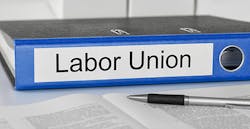The National Labor Relations Board (NLRB) reversed regulations previously adopted by the Obama-era board that allowed unions to spring an organizing vote on an employer without adequate time for it to mount an effective defense.
Called “ambush” and “quickie” election rules, they were part of the earlier pro-union board’s eight-year campaign to make it easier for labor unions to organize workplaces, a program of regulatory changes aimed at stemming the precipitous drop in union membership since the 1970s.
On Dec. 13, when the Republican-dominated board issued the new rules, the majority was careful to say that the it was not rescinding the 2014 amendments in their entirety, notes attorney C. Thomas Davis of the law firm of Ogletree Deakins. “Nonetheless, these modifications will be of great value to employers in responding to union election petitions as well as to employees who have to collect the information they need in order to decide the issue of union representation,” he says. Other employer attorneys were equally enthusiastic about the changes.
Davis also offered a detailed analysis of the significance of the new regulations, which will go into effect in mid-April 2020.
Pre-Election Hearing. The previous regulations speeded up the entire process of scheduling a union election by shortening the time between the date a union filed its petition and the date on which the pre-election hearing (in which disputes related to the election details are theoretically resolved) was scheduled to open.
Under the ambush rules, this pre-election hearing was generally scheduled to begin eight calendar days from the notice of hearing. Under the new rules, that is changed to 14 business days (not calendar days).
Notice of Petition for Election. Previously, after a petition was filed employers had to post and distribute a notice of petition for election within two business days of service of the notice of hearing. The new rules change that to five business days.
Statement of Position. One of the ambush rule’s more intrusive requirements was the employers’ obligation to develop and file a Statement of Position identifying and supporting issues in dispute, Davis says. The statement has to be filed by noon the day before the hearing is scheduled to begin (typically only seven calendar days after the notice of hearing was served).
The employer now will have eight business days after service of the hearing notice to prepare, file and serve the Statement of Position. In addition, NLRB regional directors now are permitted to extend that time for good cause.
Unions will be able to file their own Statement of Position responding to the issues raised by the employer—but it is due no later than at noon three business days before the hearing (which will be three business days after it receives the employer position statement). The current rules have no such formal written response requirement for the union, which was only obligated to make an oral response at the start of the pre-election hearing.
Making Time to Appeal
Resolution of Disputed Issues Pre-Election. A significant change made by the Obama-era board was to delay resolution of disputes over matters such as unit scope and voter eligibility until after elections were held.
Under the revised rule, those issues will now be litigated pre-election and resolved at the NLRB regional office level before an election is held. The employer and union can mutually agree to allow disputed employees to vote subject to challenge, and resolve those disputes after the election, but the timeline for resolving such disputes no longer can be forced on the employer.
Post-Hearing Briefs. At present, post-hearing briefs where the parties explain their positions on disputed issues, citing legal authority, were only allowed by a regional director. “Such permission was often denied, and the parties were often only allowed to make an oral argument at the close of the taking of evidence in the hearing,” Davis points out.
The new rule establishes the right to file a post-hearing brief after a pre-election hearing. Those briefs will be due within five business days of the close of the hearing. NLRB hearing officers will be able to grant an extension of up to 10 additional business days for good cause.
Date of Election. Under the ambush rules, NLRB regional directors are required to schedule elections “for the earliest date practicable” but do not specify a precise timeline. The new rules clarify that, absent waiver by the parties, the election normally will be scheduled no earlier than the 20th business day after direction of election is issued by the regional director.
“This timeline will allow the board to rule on certain types of requests for review prior to the election, which rarely happened under the ambush election rules,” Davis explains.
Voter List. After an election is directed, employers are required to generate a voter eligibility list with name and contact information for each eligible employee. Prior to the ambush rules, employers had to provide the NLRB with a list containing the name and home address for each voter. The board would then provide that list to the union. Before the ambush rules, employers had seven days to produce that list.
The ambush rules made significant changes to this process. The list was due just two business days after the direction of the election. More problematic, the employer was required to include on that list the voters’ home phone numbers, cell phone numbers and personal email addresses, to the extent the employer had that information.
The employer currently is obligated to turn that information over to the union directly instead of giving it to the NLRB. Under the new rules, the employer now will have five business days to furnish the voter list to the union and the NLRB regional office.
Certification of Election Results. Currently, regional directors are required to issue a certification of the results of an election where the union had won, even while the employer was appealing issues that could result in the union’s victory being set aside. The new rules end that. Results of an election no longer will be certified while an appeal is pending or while the employer still has time to file a request for review.
“These new procedures allow employers the time needed to appropriately evaluate developments related to the union petition and to protect their important business interests, which were often sacrificed to the goal of speed for speed’s sake under the ambush rules,” Davis says. “Most importantly, these amendments will better allow employees the time they need and deserve to collect information regarding the impact of union representation and to make a measured decision about what is best for them.”
About the Author

David Sparkman
founding editor
David Sparkman is founding editor of ACWI Advance (www.acwi.org), the newsletter of the American Chain of Warehouses Inc. He also heads David Sparkman Consulting, a Washington D.C. area public relations and communications firm. Prior to these he was director of industry relations for the International Warehouse Logistics Association. Sparkman has also been a freelance writer, specializing in logistics and freight transportation. He has served as vice president of communications for the American Moving and Storage Association, director of communications for the National Private Truck Council, and for two decades with American Trucking Associations on its weekly newspaper, Transport Topics.
